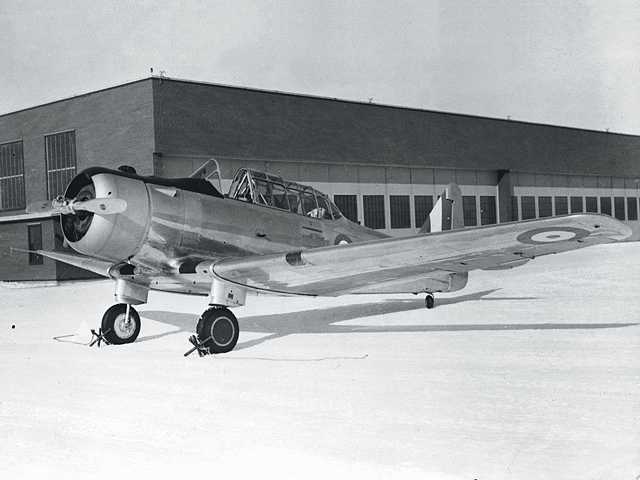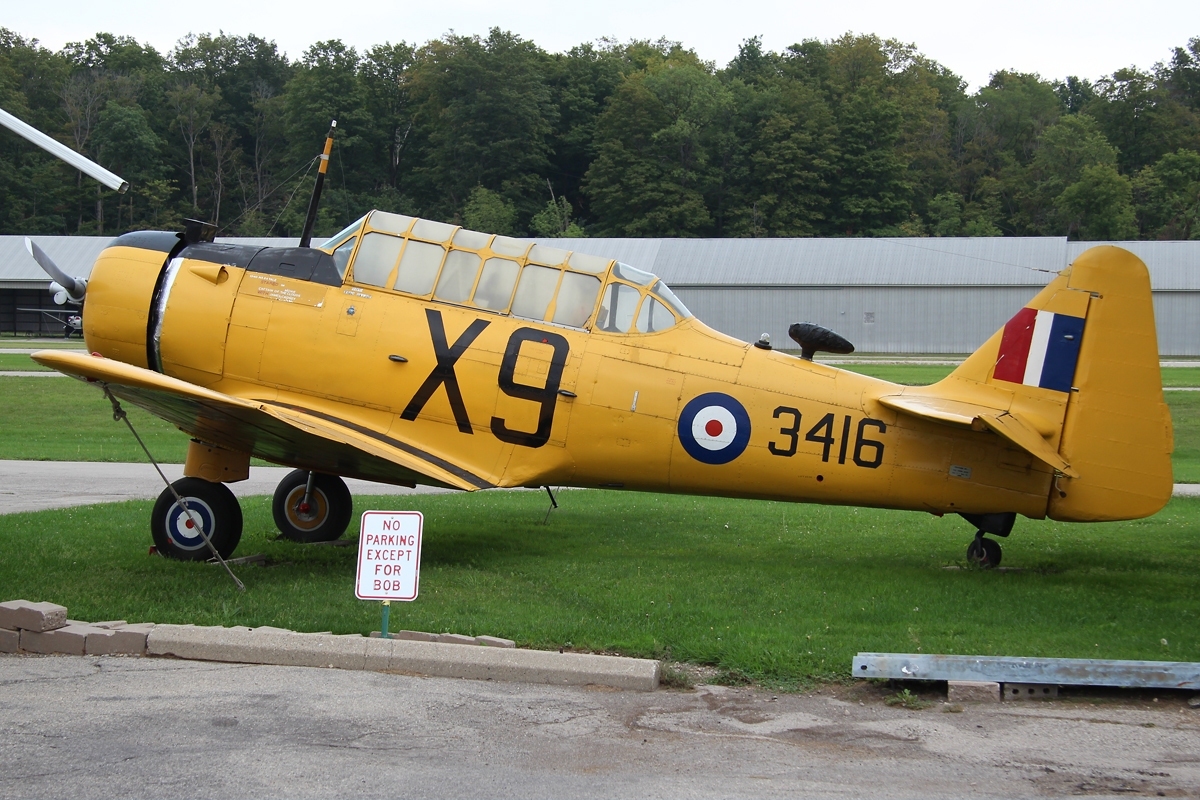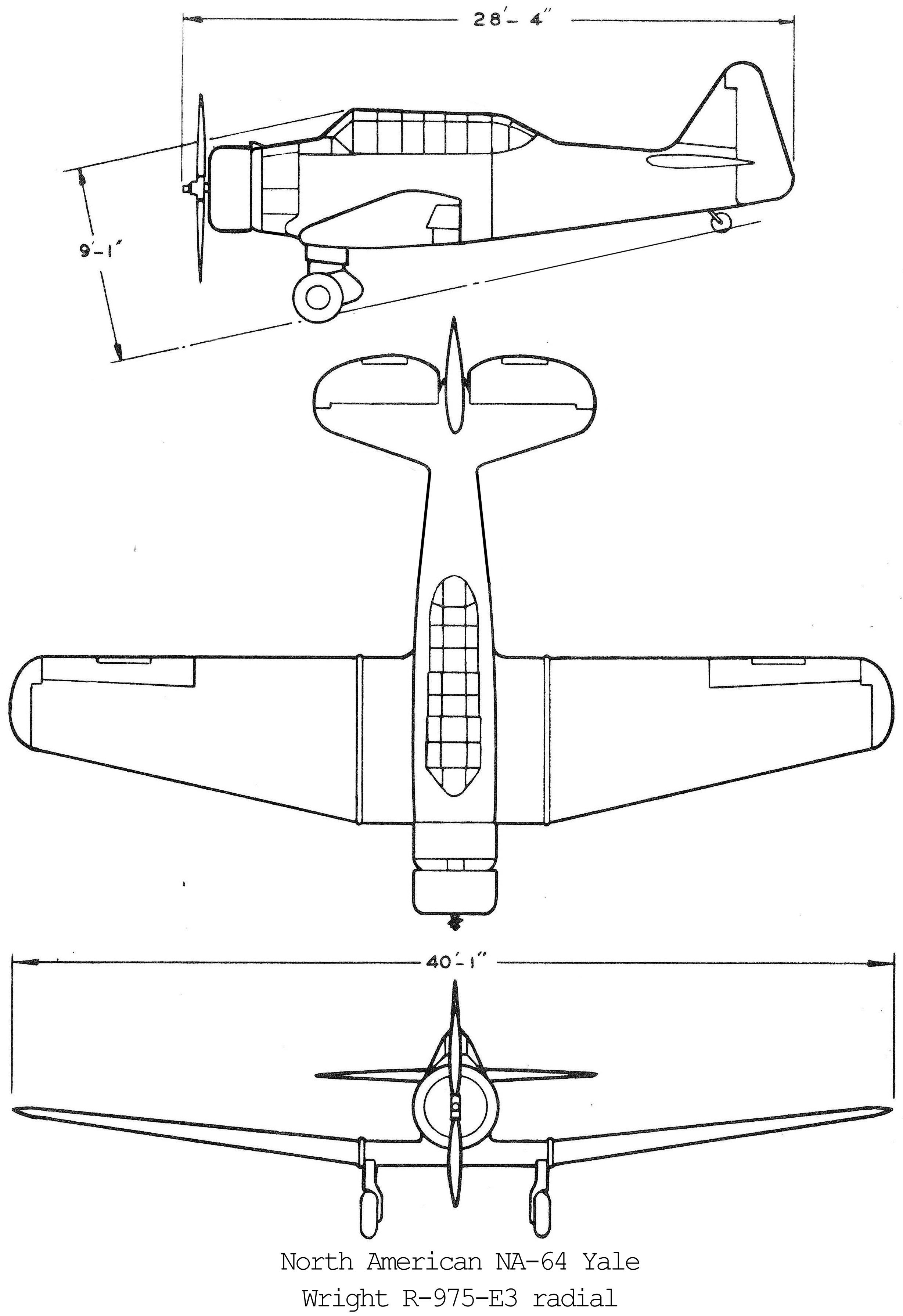North American NA-64 on:
[Wikipedia]
[Google]
[Amazon]
The North American NA-64 (NA-64 P-2 or NAA-64 P-2 in French service, Yale in Canadian service) is a low-wing single piston engine
 The NA-64 P-2 was built for the French Armée de l'Air and Aéronavale in 1939–1940, which ordered 200 and 30 respectively. Of these, 111 had been delivered before France surrendered to the Germans after the
The NA-64 P-2 was built for the French Armée de l'Air and Aéronavale in 1939–1940, which ordered 200 and 30 respectively. Of these, 111 had been delivered before France surrendered to the Germans after the
 The remaining 119 undelivered aircraft were bought up by the British Purchasing Commission and transferred to the
The remaining 119 undelivered aircraft were bought up by the British Purchasing Commission and transferred to the
 ;
*
;
*  ;
*
;
* ;
*
;
*
 There are many surviving NA-64 Yales today because of Ernie Simmons, a farmer from near Tillsonburg, Ontario. Simmons bought 39 Yales in 1946,Fletcher, 1990, p.48 along with seven Fairey Swordfish and a Westland LysanderFletcher, 1990, p.49 and kept them on his farm until he died in 1970.Fletcher, 1990, p.51 Most were auctioned the same year, and many have been restored by museums and warbird enthusiasts. Most surviving Yales are from the Simmons collection, but there are at least six surviving Yales that came from Western Canada. Three Yales have been subsequently lost, a major hangar fire took the Musée de l'air et de l'espace's NA-64 3415/64-2224, and 3454/64-2165 & 3395/64-2159 were destroyed as the result of flying accidents. Several Yales have been painted or partially modified as BT-14s.
Additionally, over a dozen are privately owned in Canada, the US, and Europe or are not accessible, and additional airframes may be held by some museums as a source of spares.
There are many surviving NA-64 Yales today because of Ernie Simmons, a farmer from near Tillsonburg, Ontario. Simmons bought 39 Yales in 1946,Fletcher, 1990, p.48 along with seven Fairey Swordfish and a Westland LysanderFletcher, 1990, p.49 and kept them on his farm until he died in 1970.Fletcher, 1990, p.51 Most were auctioned the same year, and many have been restored by museums and warbird enthusiasts. Most surviving Yales are from the Simmons collection, but there are at least six surviving Yales that came from Western Canada. Three Yales have been subsequently lost, a major hangar fire took the Musée de l'air et de l'espace's NA-64 3415/64-2224, and 3454/64-2165 & 3395/64-2159 were destroyed as the result of flying accidents. Several Yales have been painted or partially modified as BT-14s.
Additionally, over a dozen are privately owned in Canada, the US, and Europe or are not accessible, and additional airframes may be held by some museums as a source of spares.

Warbirds Directory – North American T-6 and YaleIMdB – Captains of the Clouds
{{North American Aviation aircraft NA-64 Single-engined tractor aircraft Low-wing aircraft
monoplane
A monoplane is a fixed-wing aircraft configuration with a single mainplane, in contrast to a biplane or other types of multiplanes, which have multiple planes.
A monoplane has inherently the highest efficiency and lowest drag of any wing confi ...
advanced trainer aircraft that was built for the French Air Force
The French Air and Space Force (AAE) (french: Armée de l'air et de l'espace, ) is the air and space force of the French Armed Forces. It was the first military aviation force in history, formed in 1909 as the , a service arm of the French Army; ...
and French Navy
The French Navy (french: Marine nationale, lit=National Navy), informally , is the maritime arm of the French Armed Forces and one of the five military service branches of France. It is among the largest and most powerful naval forces in t ...
, served with the Royal Canadian Air Force
The Royal Canadian Air Force (RCAF; french: Aviation royale canadienne, ARC) is the air and space force of Canada. Its role is to "provide the Canadian Forces with relevant, responsive and effective airpower". The RCAF is one of three environm ...
, and with the Luftwaffe
The ''Luftwaffe'' () was the aerial-warfare branch of the German ''Wehrmacht'' before and during World War II. Germany's military air arms during World War I, the ''Luftstreitkräfte'' of the Imperial Army and the '' Marine-Fliegerabtei ...
as a captured aircraft during World War II
World War II or the Second World War, often abbreviated as WWII or WW2, was a world war that lasted from 1939 to 1945. It involved the vast majority of the world's countries—including all of the great powers—forming two opposin ...
.
Design and development
Ordered as a follow-on to the NA-57 as a two-seat advanced trainer, the NA-64 P-2/NAA-64 P-2 represented a major structural improvement, with a longer all-metal fuselage replacing the fabric covered fuselage of the NA-57. As well as metal skin replacing the fabric on the fuselage, the fin was changed from having a corrugated skin to being a smooth stressed skin structure and was moved slightly aft, lengthening the rear fuselage while the engine was moved forward to maintain thecenter of gravity
In physics, the center of mass of a distribution of mass in space (sometimes referred to as the balance point) is the unique point where the weight function, weighted relative position (vector), position of the distributed mass sums to zero. Thi ...
. The rudder was also changed from the rounded shape used previously to one with a roughly triangular shape with the broadest part being at the bottom to improve handling at high angles of attack. In one respect however, it was a step backwards from its immediate predecessor, the BT-14, with which it is often confused, in that the earlier straight wings were used with the result that in RCAF service, when compared to the later and more powerful Harvard II it was flown alongside, it had different handling characteristics and lower performance.Fletcher, 1990, p.37
Operational history
France
 The NA-64 P-2 was built for the French Armée de l'Air and Aéronavale in 1939–1940, which ordered 200 and 30 respectively. Of these, 111 had been delivered before France surrendered to the Germans after the
The NA-64 P-2 was built for the French Armée de l'Air and Aéronavale in 1939–1940, which ordered 200 and 30 respectively. Of these, 111 had been delivered before France surrendered to the Germans after the Battle of France
The Battle of France (french: bataille de France) (10 May – 25 June 1940), also known as the Western Campaign ('), the French Campaign (german: Frankreichfeldzug, ) and the Fall of France, was the Nazi Germany, German invasion of French Third Rep ...
.Hagedorn, 1997, p.48 In France, the NA-64, like the NA-57 before it, was known as the North,Fletcher, 1990, p.36 and was designated as NAA-64 P-2 (abbreviated from ''North American Aviation modèle 64 perfectionnement, 2 places'' (North American Aviation model 64 advanced trainer, 2 seats)) but were sometimes attached to reconnaissance units. A small number escaped the Germans to be used by the Vichy French Air Force. Two examples in North Africa survived into the postwar years, having been operated alongside NA-57s, the last only being retired in 1949.
Canada
 The remaining 119 undelivered aircraft were bought up by the British Purchasing Commission and transferred to the
The remaining 119 undelivered aircraft were bought up by the British Purchasing Commission and transferred to the Royal Canadian Air Force
The Royal Canadian Air Force (RCAF; french: Aviation royale canadienne, ARC) is the air and space force of Canada. Its role is to "provide the Canadian Forces with relevant, responsive and effective airpower". The RCAF is one of three environm ...
(RCAF) for the British Commonwealth Air Training Plan
The British Commonwealth Air Training Plan (BCATP), or Empire Air Training Scheme (EATS) often referred to as simply "The Plan", was a massive, joint military aircrew training program created by the United Kingdom, Canada, Australia and New Zea ...
between August and September 1940, and all were operational by NovemberFletcher, 1990, p.38 The type was named the Yale Mk.IAs there was no Yale Mk.II, the Mk.I part of the designation was rarely used. following British naming practice of naming trainers after education institutions and US-supplied aircraft after American locations, in this case, Yale University, and were used initially as intermediate pilot trainers taking pilots from the de Havilland Tiger Moth
The de Havilland DH.82 Tiger Moth is a 1930s British biplane designed by Geoffrey de Havilland and built by the de Havilland Aircraft Company. It was operated by the Royal Air Force (RAF) and other operators as a primary trainer aircraft. ...
and Fleet Finch to the much faster and more complex North American Harvard
The North American Aviation T-6 Texan is an American single-engined advanced trainer aircraft used to train pilots of the United States Army Air Forces (USAAF), United States Navy, Royal Air Force, Royal Canadian Air Force and other air forces ...
, until this category was dispensed with as being unnecessary. They were then relegated for use as airborne wireless radio trainers, along with the contemporary Fleet Fort intermediate trainer in 1943.Fletcher, 1990, p.42Fletcher, 1990, p.45 Prior to service entry, the throttle and engine mixture controls were modified from the system used by the French whereby the throttle was pulled back to increase power, and the mixture control pulled back to lean out the mixture, to the system used on the Harvard. The Yale appeared in the movie '' Captains of the Clouds''. The RCAF sold all surviving examples off as scrap in 1946 but over 30 survive today as a result of a large number of them being bought surplus by a single farmer, with about 15 currently in airworthy condition.
Germany
The NAA-64s captured from the French were used by the GermanLuftwaffe
The ''Luftwaffe'' () was the aerial-warfare branch of the German ''Wehrmacht'' before and during World War II. Germany's military air arms during World War I, the ''Luftstreitkräfte'' of the Imperial Army and the '' Marine-Fliegerabtei ...
for all types of flight training, from basic flying to advanced fighter tactics. Dive bomber schools and target tug units and even combat squadrons all used the NAA-64, as they were designated by the Luftwaffe, from the tail markings of the French examples. At least one was used by the Zirkus Rosarius
''Zirkus Rosarius'' (also known as the ''Wanderzirkus Rosarius'') was an ''Erprobungskommando''-style special test unit of the Luftwaffe, specifically of the Luftwaffe High Command, tasked with testing captured British and American aircraft, all o ...
to familiarize German aircrew with the handling of American aircraft before they evaluated captured aircraft.
Operators
 ;
*
;
* Royal Canadian Air Force
The Royal Canadian Air Force (RCAF; french: Aviation royale canadienne, ARC) is the air and space force of Canada. Its role is to "provide the Canadian Forces with relevant, responsive and effective airpower". The RCAF is one of three environm ...
**No.1 Service Flying Training School (No. 1 SFTS) BordenFletcher, 1990, p.40
** No.2 Service Flying Training School (No. 2 SFTS) Uplands
** No.6 Service Flying Training School (No. 6 SFTS) Dunnville
** No.14 Service Flying Training School (No. 14 SFTS) AylmerFletcher, 1990, p.172
**No.1 Training Command (1TC) Toronto, ON
**No.3 Training Command (3TC) MontrealFletcher, 1990, p.171
**No.4 Training Command (4TC) Regina
**No.1 Flying Instructor School (1FIS) Trenton
**No.1 Wireless School (1WS) Winnipeg, MB
**No.2 Wireless School (2WS) Calgary
Calgary ( ) is the largest city in the western Canadian province of Alberta and the largest metro area of the three Prairie Provinces. As of 2021, the city proper had a population of 1,306,784 and a metropolitan population of 1,481,806, makin ...
, AB
**No.3 Wireless School (3WS) Montreal, QCFletcher, 1990, p.43
** No.4 Wireless School (4WS), Guelph
** No.12 (Communications) Squadron
French Air Force
The French Air and Space Force (AAE) (french: Armée de l'air et de l'espace, ) is the air and space force of the French Armed Forces. It was the first military aviation force in history, formed in 1909 as the , a service arm of the French Army; ...
(''Armée de l'Air'')
**''Escadrille d'Outre Mer'' 82 Niger (post-WWII)
*French Navy
The French Navy (french: Marine nationale, lit=National Navy), informally , is the maritime arm of the French Armed Forces and one of the five military service branches of France. It is among the largest and most powerful naval forces in t ...
(''Marine Nationale'')
** French Naval Aviation (''Aéronavale'')
***Section Liaison Port Lyautey
Kenitra ( ar, القُنَيْطَرَة, , , ; ber, ⵇⵏⵉⵟⵔⴰ, Qniṭra; french: Kénitra) is a city in north western Morocco, formerly known as Port Lyautey from 1932 to 1956. It is a port on the Sebou river, has a population in 201 ...
51 S squadron ( Khouribga)
* Vichy French Air Force (''Armée de l'Air de Vichy'')
** ''Groupe de Chasse'' II/9 (fighter-trainer) – Aulnat
Aulnat () is a commune in the Puy-de-Dôme department in Auvergne-Rhône-Alpes in central France.
Population
See also
*Communes of the Puy-de-Dôme department
The following is a list of the 464 communes of the Puy-de-Dôme department of Fr ...
* Free French Air Force (''Forces Aériennes Françaises Libres'')s
Luftwaffe
The ''Luftwaffe'' () was the aerial-warfare branch of the German ''Wehrmacht'' before and during World War II. Germany's military air arms during World War I, the ''Luftstreitkräfte'' of the Imperial Army and the '' Marine-Fliegerabtei ...
captured 93 aircraft and assigned 96 registrations, and they published their own pilots manual for it
**'' Fliegerzielgeschwader Fl.Z.G. 2'' target towing wing
**'' Flugzeugführerschule A/B 9'' pilot school
**'' Flugzeugführerschule A/B 16'' pilot school
**'' Flugzeugführerschule A/B 42'' pilot school
**'' Flugzeugführerschule A/B 43'' pilot school
**'' Flugzeugführerschule A/B 71'' pilot school
**'' Flugzeugführerschule A/B 82'' pilot school
**'' Flugzeugführerschule A/B 110'' pilot school
**'' Flugzeugführerschule A/B 111'' pilot school
**'' Flugzeugführerschule A/B 116 Göppingen'' pilot school
**'' Flugzeugführerschule A/B 117'' pilot school
**'' Jagdfliegerschule JFS 2 Neustadt Weinstraße/Speyerdorf'' advanced fighter pilot school
**'' Jagdfliegerschule JFS 6'' advanced fighter pilot training school
**'' Jagdfliegervorschule JFVS 2 Lachen-Speyerdorf'' preliminary fighter pilot school
**'' Jagdgeschwader JG 103'' fighter squadron
**'' Jagdgeschwader JG 106'' fighter squadron
**'' Luftdienst-Kommando 7'' air service command
**'' Luftkriegschule LKS 1'' air war school
**'' Luftkriegschule LKS 5'' air war school
**'' Nahaufklärungsgeschwader NAG 102'' short-range reconnaissance wing
**'' Stukaschule StS 1 Wertheim'' dive bomber school
**'' Sturzkampffliegervorschule StVS 1 Bad Aibling'' preliminary dive bomber school
**'' Stukavorschule SVS 2'' preliminary dive bomber school
**'' Zerstörerschule ZS 1 Neubiberg'' heavy fighter school
**'' Zieldarstellungsstaffel ZD-Stf 102'' target towing squadron
**''Zirkus Rosarius
''Zirkus Rosarius'' (also known as the ''Wanderzirkus Rosarius'') was an ''Erprobungskommando''-style special test unit of the Luftwaffe, specifically of the Luftwaffe High Command, tasked with testing captured British and American aircraft, all o ...
'' used to familiarize aircrew with U.S. aircraft.
;
* Royal Navy
** 31 SFTS Kingston, ON (Canada) – eight loaned from RCAF from March to April 1941 in exchange for eight Fairey Battle trainers.Fletcher, 1990, p. 41
Surviving aircraft
 There are many surviving NA-64 Yales today because of Ernie Simmons, a farmer from near Tillsonburg, Ontario. Simmons bought 39 Yales in 1946,Fletcher, 1990, p.48 along with seven Fairey Swordfish and a Westland LysanderFletcher, 1990, p.49 and kept them on his farm until he died in 1970.Fletcher, 1990, p.51 Most were auctioned the same year, and many have been restored by museums and warbird enthusiasts. Most surviving Yales are from the Simmons collection, but there are at least six surviving Yales that came from Western Canada. Three Yales have been subsequently lost, a major hangar fire took the Musée de l'air et de l'espace's NA-64 3415/64-2224, and 3454/64-2165 & 3395/64-2159 were destroyed as the result of flying accidents. Several Yales have been painted or partially modified as BT-14s.
Additionally, over a dozen are privately owned in Canada, the US, and Europe or are not accessible, and additional airframes may be held by some museums as a source of spares.
There are many surviving NA-64 Yales today because of Ernie Simmons, a farmer from near Tillsonburg, Ontario. Simmons bought 39 Yales in 1946,Fletcher, 1990, p.48 along with seven Fairey Swordfish and a Westland LysanderFletcher, 1990, p.49 and kept them on his farm until he died in 1970.Fletcher, 1990, p.51 Most were auctioned the same year, and many have been restored by museums and warbird enthusiasts. Most surviving Yales are from the Simmons collection, but there are at least six surviving Yales that came from Western Canada. Three Yales have been subsequently lost, a major hangar fire took the Musée de l'air et de l'espace's NA-64 3415/64-2224, and 3454/64-2165 & 3395/64-2159 were destroyed as the result of flying accidents. Several Yales have been painted or partially modified as BT-14s.
Additionally, over a dozen are privately owned in Canada, the US, and Europe or are not accessible, and additional airframes may be held by some museums as a source of spares.
Specifications

See also
References
Notes
Bibliography
* * * * * * * * *External links
Warbirds Directory – North American T-6 and Yale
{{North American Aviation aircraft NA-64 Single-engined tractor aircraft Low-wing aircraft